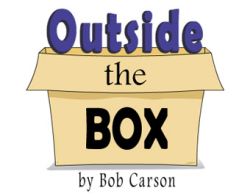The Calcutta
September 24, 2018,by Bob Carson
Editor’s Note: The USTA website is pleased to present freelance writer Bob Carson and his popular “Outside the Box” features. This monthly series is a menu of outlandish proposals presented with a wink — but the purpose behind them is serious. The views contained in this column are that of the author alone, and do not necessarily represent the opinions or views of the United States Trotting Association.

Bob Carson
Spreading the gospel to both the existing harness congregation and the world that never hears our calling is difficult. They are, of course, two different audiences. But, let’s try.
A Calcutta is a competition that involves an auction for the participants. This has long been a popular play in clubhouses around the world. You may have participated in some of the myriad forms of these entertaining little ventures.
Here is an example. Last April, the Masters golf tournament with 80 players teed off on the lush fairways and velvet greens of Augusta National Golf Club. The field included favorites like Phil Mickelson and Bubba Watson, middle of the road players like Matt Kuchar and Patrick Reed, and golfers you never heard of like Lin Yuxin and Shubhankar Sharma. In a Calcutta auction, all 80 were for sale. Your goal as a participant was to bid and buy one player. The Calcutta closes once all the players have an owner.
A blind auction determines the price of each player. The total paid for all 80 players goes into a pool. If you are the successful bidder on a player, he is yours for the tournament. You wait, watch, and see if your player wins. Calcuttas are fun.

Transfer this concept to harness horses because the internet now makes it feasible. The long winter month of January would be the optimal time to hold the auction. The operator will need a lawyer to secure charitable standing and monitor the funds. Here is a rough prototype of one method for a Calcutta in our sport.
A select group of 100 promising yearlings passing through the fall sales ring will make up our pool (the list will be subjective and it will certainly not contain every yearling). The pool of 100 yearlings are divided into five groups. The groups are posted with two weeks of “study” time for potential participants in the Calcutta. Then a series of daily blind auctions take place online.
The minimum bid is $100. As a participant, you are trying to pick the top yearling sold in this group of 100 that will race as a 2-year-old in 2019. Purse money will be the measurement.
For example, after studying the first group of 20 horses, you see a yearling you believe is terrific. This one is a Muscle Hill colt named Calcutta Calvin that sold at Lexington for $230,000. You can bid the minimum $100, but many people will have eyes on this horse as a wonderful prospect, so it not likely you will get him for the minimum bid. You think hard and decide your blind bid will be $402.
Day one of “Auction Reveal Week” will be an exciting day. You will see if your bid of $402 is the winning blind auction bid. If your bid did not hold up, you have other days and other chances.
When the auction is over, 100 people (or groups of people) will each have (hypothetical) ownership of a 2-year-old horse. Let us say your bid for Calcutta Calvin held up and was the winning bid. He is your horse for 2019. To win, he needs to earn the most money.
How much could you win?
That always depends on how much money is in the pool. It is likely many of the horses in the pool will sell above the minimum, perhaps a few hot prospects will sell very high. Say the average is $250 per horse, which puts $25,000 in the winning pool. However, and this is very important and the crux of this idea, half of the money in the pool ($12,500) will go to charity for horse retirement funding.
Therefore, if Calcutta Calvin is the best of these 100, you win $12,500.
What are the benefits?
Charity: Anytime our sport can generate positive publicity, it is good. A check to horse retirement funding, opioid addiction, or any other pre-designated charity offers publicity and social media attention.
Interest: It would be fun. Ask yourself, would I participate? Would I bid on a horse and get my ticket for an entire season of following the progress of my horse?
New Faces: This is also an important pillar of the process. Imagine that you have some pals who are not into harness racing. They are not gamblers, they are not owners, but you split your ticket with four of them. For a relatively small amount of money, they would get a season to follow “their horse” where you could be their guide and introduce them to our sport.
Who Loses: This is always the big test. You could say the 99 people who do not win the Calcutta are losers, but not really. They still have fun for a small investment and they understand that half of their auction bid goes to charity.
Who Would Run the Calcutta: Perhaps a certified horse rescue and retirement organization would find this a useful vehicle for fundraising. Perhaps a large breeding farm would see the value. The experiment would be fun.
Is this our answer to relevance? Of course not, but it could be another brick in the wall. As a member of the choir, would you consider this idea? If you never heard of the sport of harness horse racing and a friend nudged you, would you play?
In both cases, my answer would be yes.
